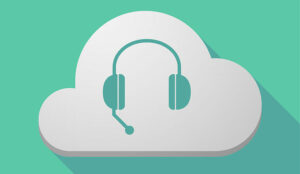Anikó Illés of VCC Live shares her advice to contact centres of all sizes for moving to the cloud.
As your software as a service (SaaS) start-up becomes larger in scale, you might have started thinking about the changing relationship between you and your customers.
Common concerns for developing SaaS start-ups involve how to handle customer relationships through various stages of the business and what technology to use to develop customer support.
How to provide the best customer support along with investing in the right technology?
Allow us to guide you through the process of setting up your customer experience strategy foundations, from the early stage to the scale-up stage of SaaS start-ups.
Founding Stage to Early Stage (0–20 Employees)
At the founding stage of your business (0–5 employees), one-to-one customer interaction is key. At this level, it is likely that every member of your small team is communicating with clients. The natural aim for your small staff here is to actively research how to better fit your product to consumer needs.
Customers are essential for this process. Through their feedback, you can fine-tune your place in the market.
As your business gets to the early stage (5–20 employees), you will likely have to hire your first employee, dealing exclusively with customer support and customer service.
This way, the very important strategic task of customer communications will be concentrated in the hands of a single person, allowing the rest of the team to focus on your product. While this role might be hard to fulfil in the beginning, it is essential in developing the base of your customer communications standards.
Here is where you lay the foundations of your future communications and define your business model in terms of customer support and service. The first step in laying a solid foundation for this is getting your interactions organized in one place.
Customer communications usually come from a variety of channels, such as emails, phone calls, or social media, depending on your business. Establish a mainline for customer support to keep your interactions untangled and manageable. Having a well-organized channel lays the foundations for later stages of your business.
In order to further help the process of developing a well-established system of customer support, ask for feedback, and start thinking about the right metrics. At this stage, you can set up a post-interaction NPS.
Net Promoter Score helps you track customer loyalty and is a very easy metric to calculate. After using your product, just ask your customers: “How likely is it that you would recommend us to a friend or colleague?” Answers are scaled from 0–10, with 10 being the most positive.
Answers are categorized under: promoters (9–10), passives (7–8), and detractors (0–6). Calculate your NPS score by subtracting the percentage of detractors from the percentage of promoters.
Another important metric to track at this stage is your Retention rate. The retention rate calculates the number of customers that remain or leave your company. An easy way to calculate this is simply to subtract the number of new customers from your total customers at the end of a set period and then divide the resulting number by the number of customers you started with during the period in question.
Establishing a feedback system along with the right metrics will also enable you to identify the patterns in the issues that clients encountered, so you can fine-tune your business processes and identify any potential bugs in your product.
The insight you gain from this data can help you with the process of building customer self-service, such as FAQ or email templates that help customers answer some common questions in relation to your business. A FAQ page can be especially useful for your start-up at this stage as customer service teams still have a limited number of staff.
If customers find the answer they are looking for on the FAQ page they won’t have to call and keep the service lines busy.
Mid Stage (20–100 Employees)
During this stage, your customer base is rapidly increasing, and along with it, so are your customer support employees. Ideally, you have at least ten percent of the total number of employees dealing exclusively with customer communications, but the size of the team will heavily depend on your product.
Low-touch products require a low level of personal contact with customers, and part of the customer service can be automated. If your product is high-touch, you’ll probably need to create a more personalized and consultative approach, sometimes involving a key account manager.
The value of high-touch customer service has to be included in the pricing of your SaaS so your operations remain profitable.
Speaking of personalization, this is when you will want to expand your communication channels, and offer your customers more possibilities of contacting you. While it’s important to expand your reachability, be thoughtful of what channel you add to your communications.
Once you add a channel, make sure you have a strategy in place for maintaining it. It’s hard to remove a channel once you added it, so make sure you use relevant ones.
The process of solving issues through customer feedback that you started in the early stage of your start-up can be further developed here. By the time you reach around 1,000 customers, you should be able to see the most common questions they run into.
Aim to expand on your educational content and start building a knowledge base. Start devising a plan for webinars, tutorials, and lectures in order to keep existing customers educated about your product or services.
At this stage, you can add a further metric, to see if the processes started in the early stage of your start-up have been successful in achieving customer success. The key metric to remember here is response/resolution time.
Response/resolution time is the period that it takes to acknowledge a customer’s issue and notify them about the problem having been addressed and the time it takes to resolve the addressed issue. Aim to set time-realistic targets to your SaaS start-up and increment them as your business increases, to keep up with the scaling challenges.
Growth Stage (100–250 Employees)
At this stage, you have likely established yourself in your specific market segment. Until this point, you have been handling direct customer support issues, fine-tuning your business processes, and maturing your service or product.
However, at this stage, it is time to think about actively retaining customers and building permanent systems based on the feedback you collected in previous stages.
In terms of your customer support, invest in advanced technology that helps you manage and organize your increasing customer enquiries.
Once you decide on the proper channels of communication, use software that enables you to manage them all in one place, in other words, omnichannel communications.
Contemporary customer service and support are expected to not only function properly on multiple channels but also to offer customers a unified experience between them. Customers are no longer used to repeating what they said previously to another customer support employee through a different channel. Instead, they expect that the person they’re talking to knows their interaction history and efficiently solves their issues.
By aligning your channels, your customer communications specialist will be able to instantly identify the needs of the customer they are handling, regardless of when and where previous employees talked to them. Something that the customer said on social media, phone, or email will be available on a single platform to be seen. This not only helps you with the obvious challenge of managing a larger operation but also with the process of actively retaining and nourishing your customers.
This is the stage in which you will already need a Head of Customer Support professional who will oversee a team dealing with customer interactions. To help your new hire manage their team, have the proper technology in place, such as call monitoring software.
Call monitoring is an essential component to any organization dealing with sales over the phone (pitching) or customer support on the phone.
Taking the time to listen in and assess the quality of phone conversations between employees and customers is essential for providing good service, customer loyalty, and revenue.
As we have previously written, the goal of call monitoring is to identify the best and worst practices of your contact centre operations in order to identify calls that do not meet your business standards and in order to continuously improve your customer contact goals for a faster, more effective, and seamless customer interaction. For this, many vendors offer features such as live dashboards that track the real-time performance of your customer support efforts to help your customer support staff on their best performance.
However, it is worth mentioning: try not to put your processes before the needs of your team. Make sure that your customer support team feels trusted and create space for them to actively contribute to the fine-tuning of your client interactions, instead of making them feel like cogs in a machine.
The most important new metric to remember here is Average Revenue Per User (ARPU). ARPU measures the amount of revenue that a business is expected to generate from a single customer. ARPU is a great tool for analysing your growth patterns and comparing your success with competitors.
You can calculate ARPU by dividing the total revenue of the business by its total number of users. ARPU can be especially useful for SaaS start-ups, as it can help a business determine which of its offers drive the most revenue and fine-tune the pricing of its subscription packages.
ARPU can also help you in re-evaluating your customer support and contract models. For example, offering direct human customer support has a cost which the pricing model needs to be able to sustain.
Therefore, a plug-and-play SaaS product might only need self-serve support, while premium partners or users get human support.
However, in the case of B2B SaaS, where solutions are often complex and unique, human support is essential. Therefore, make sure to include this cost in your pricing model and remember: B2B segments are more likely to accept support pricing.
Scale-Up (250+)
As you enter the realms of the scale-up phase of your company, with 250+ employees, you might want to step back and reconsider things for a minute. During this phase, there is usually a tendency to try and keep costs down.
However, in the process, remember that even at this level, you need to continue being devoted to your customers. Customer communication here remains one of the key drivers towards gaining new leads and revenue. Focus on the regional aspects of your company and find technology that fits the scale of your sales and purchases.
At this level, it is likely that your start-up will expand to the level where you need to establish regional representatives dealing with customer support. This might mean having employees in different time zones and working in different languages. Make sure to set the right technology, as at this stage call routing features that route the customer requests and assign them to the most appropriate agents is fundamental to remain efficient.
Inevitably, it will mean a permanently remote workforce and remote customer contact centres.
Make sure that your regional, head of customer support, and success officers are able to oversee these processes. As discussed in the above section, call monitoring technologies and real-time KPIs enable your team managers to have quantifiable oversight from any distance.
It is also time to invest in tech that fits the scale of your sales. At this point, you might want to start thinking about adding features to your sales that enable the serving of your increasingly growing customer base.
The bigger you get, and especially if you are sailing on international waters, you have to make the availability of your product or service as seamless as possible.
Besides omnichannel and monitoring features, you also need to think about investing in solid technology that directly helps you with the immediate sales process. This could mean ease of payment and identification.
Customer identification technology similarly helps your sales contracts. Customer identification is a simple, quick, and highly secure method of remotely verifying customers.
Initially taken up by the financial sector, identifying clients with video ID has become the preferred choice of a host of other companies in a variety of sectors.
Video ID technology can help you with contract activation, cancellations, and upgrades. As we have written before, it is a technology that proves to be speedy and safe, and it is definitely here to stay.
At the end of the day, no matter what technology you invest in, make sure that your operation, no matter what its scale, is founded on secure technology.
Besides reviewing your data compliance and operations security, make sure that the technology you invest and build your operations on is itself on solid ground and ensures business continuity.
Thanks to the combination of expanded user-right options and two-factor authentication, many vendors can now offer the highest levels of security to the software as well as to your operations.
Hopefully, this guide has helped you in thinking strategically about your start-up, no matter what stage your operations are in. The bottom line? Strategically collect data from the very first step, establish metrics and models based on your findings, and invest in the technologies that fit the scale and needs of your operations.
Author: Robyn Coppell
Published On: 18th May 2020 - Last modified: 19th Jul 2022
Read more about - Guest Blogs, VCC Live



































